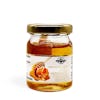PAIRS PERFECTLY WITH
Bees get their food from the European acacia tree, which is where acacia honey gets its name. In comparison to other honeys, this one has a paler golden hue. It takes a long time to crystallize and feels silky to the touch. The Alba truffle shavings provide a particular sweetness and smokiness to the flavor, making it a sought-after treat for connoisseurs.
For both sweet and savory meals, Urbani Tartufi’s organic white truffle honey is an excellent choice. A cheese board may be enhanced by its particular flavor, from soft and fresh to hard and aged, by sprinkling it on top. It pairs particularly well with blue cheeses like Fourme d’Ambert and Parmigiano Reggiano DOP, both of which are hard, nutty cheeses. Salad and glazes may also be made with this honey. Honey-nut cookies or scones are equally delicious when made this way.
Acacia honey is sought after both because of its rarity and because of the exact conditions that must be met each year in order to collect enough of this honey.
Acacias bloom in May, just as bees are beginning to gather their yearly feed in large numbers (think of it as harvest time for them!) but they are also in the process of separating from their mother hives in order to locate new dwellings and queens to follow in their footsteps. The type of year it is is also a deciding element. Rain is necessary for nectar production, but too much rain washes nectar away before the bees can get to it. Acacia honey has earned its renown due to the myriad factors that go into its production.
Storage Instructions
Store in a cool dry place. Refrigerate upon opening.





